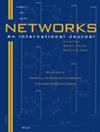通过将开始时间分配给行走集合获得的时间图中的最大可达性
IF 1.3
4区 计算机科学
Q4 COMPUTER SCIENCE, HARDWARE & ARCHITECTURE
引用次数: 2
摘要
在时间图中,每条边都会出现,并且可以在特定的时间点进行遍历。在这样的图中,一个节点与另一个节点的时间可达性自然地被边缘按时间顺序出现的时间路径的存在所捕获。受公共交通网络中公交/地铁/有轨电车时间表优化的启发,我们考虑了通过为每次出行分配开始时间,将有向图中的步行集合(称为出行)转化为时间图的问题,以最大限度地提高节点对之间的可达性。每次旅行都代表着一辆车的轨迹,它的边缘必须一个接一个地安排。因此,设置行程的开始时间会强制其所有边缘的出现时间。我们将这种起始时间分配称为行程时间化。我们得到了几个关于通过行程时间化来最大化可达性的复杂性的结果。其中,我们表明,在n$$n$$顶点有向图中,通过行程时间化来最大化可达性很难在因子n/12$$\sqrt{n}/12$$内近似,即使我们假设每对节点都存在连接它们的行程时间化。从积极的方面来看,我们证明,如果我们另外假设对称性,即当要调度的旅行集合是这样的时,对于每个旅行,都有一个以相反顺序访问相同节点的对称旅行,那么必须存在连接所有对的恒定部分的旅行时间化。本文章由计算机程序翻译,如有差异,请以英文原文为准。
Maximizing reachability in a temporal graph obtained by assigning starting times to a collection of walks
In a temporal graph, each edge appears and can be traversed at specific points in time. In such a graph, temporal reachability of one node from another is naturally captured by the existence of a temporal path where edges appear in chronological order. Inspired by the optimization of bus/metro/tramway schedules in a public transport network, we consider the problem of turning a collection of walks (called trips) in a directed graph into a temporal graph by assigning a starting time to each trip in order to maximize the reachability among pairs of nodes. Each trip represents the trajectory of a vehicle and its edges must be scheduled one right after another. Setting a starting time to the trip thus forces the appearance time of all its edges. We call such a starting time assignment a trip temporalization. We obtain several results about the complexity of maximizing reachability via trip temporalization. Among them, we show that maximizing reachability via trip temporalization is hard to approximate within a factor n/12$$ \sqrt{n}/12 $$ in an n$$ n $$ ‐vertex digraph, even if we assume that for each pair of nodes, there exists a trip temporalization connecting them. On the positive side, we show that there must exist a trip temporalization connecting a constant fraction of all pairs if we additionally assume symmetry, that is, when the collection of trips to be scheduled is such that, for each trip, there is a symmetric trip visiting the same nodes in reverse order.
求助全文
通过发布文献求助,成功后即可免费获取论文全文。
去求助
来源期刊

Networks
工程技术-计算机:硬件
CiteScore
4.40
自引率
9.50%
发文量
46
审稿时长
12 months
期刊介绍:
Network problems are pervasive in our modern technological society, as witnessed by our reliance on physical networks that provide power, communication, and transportation. As well, a number of processes can be modeled using logical networks, as in the scheduling of interdependent tasks, the dating of archaeological artifacts, or the compilation of subroutines comprising a large computer program. Networks provide a common framework for posing and studying problems that often have wider applicability than their originating context.
The goal of this journal is to provide a central forum for the distribution of timely information about network problems, their design and mathematical analysis, as well as efficient algorithms for carrying out optimization on networks. The nonstandard modeling of diverse processes using networks and network concepts is also of interest. Consequently, the disciplines that are useful in studying networks are varied, including applied mathematics, operations research, computer science, discrete mathematics, and economics.
Networks publishes material on the analytic modeling of problems using networks, the mathematical analysis of network problems, the design of computationally efficient network algorithms, and innovative case studies of successful network applications. We do not typically publish works that fall in the realm of pure graph theory (without significant algorithmic and modeling contributions) or papers that deal with engineering aspects of network design. Since the audience for this journal is then necessarily broad, articles that impact multiple application areas or that creatively use new or existing methodologies are especially appropriate. We seek to publish original, well-written research papers that make a substantive contribution to the knowledge base. In addition, tutorial and survey articles are welcomed. All manuscripts are carefully refereed.
 求助内容:
求助内容: 应助结果提醒方式:
应助结果提醒方式:


